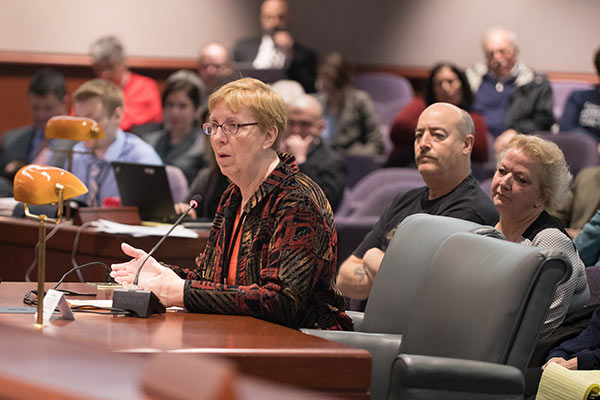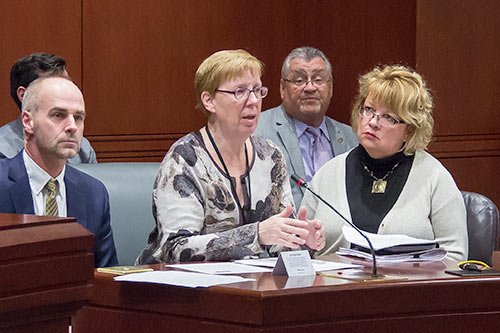HARTFORD, CT— State Senator John Fonfara (D-Hartford) submitted the following written testimony to the Transportation Committee Monday in support of a bill that would see the State Department of Transportation study the construction of tunnels to alleviate traffic at the Interstate 84 and 91 interchange in Hartford:
Like many similar Interstate Highway interchanges of its era, Hartford’s I-84/I-91 interchange and viaduct are approaching the end of their useful life.
Fortuitously, CONDOT has undertaken a project which begins to grapple with the challenge of how best to replace this aging highway alignment and complex system of raised structures in ways that respond not only to transportation needs, but also to essential elements of urban design and economic development imperatives. As the “I-84/I-91 Interchange Study” examines alternative solutions to replace the Interchange, Hartford has an historic opportunity to renew its transportation infrastructure, remove a monumental Architectural barrier dividing the State’s Capital City, improve Hartford making it a more livable City, resolve a very real problem with the Hartford Levee System caused by the lowering of I-91 in the 1990’s and promote economic development around a renewed transportation Infrastructure that will serve the State and the Capital Region for the next Century.
It is essential that this Study embraces a bold 100-year solution that solves all the problems which have arisen due to inadequacies related to the current interchange. From the onset of this very large undertaking, it is our obligation to note that an under-engineered plan to upgrade the interchange was implemented in the 1990’s. That historic effort took years to complete, caused immeasurable losses to the motoring public in the form of traffic congestion and delays, cost $200M+ to complete and was opened to traffic in 1998. The bridges and highways included in that project were designed for a 75-year service life. Due to a total lack of vision and a wholly inadequate project design, we are already planning their replacement less than 20 years into that design life. With the current study and opportunity to correct these mistakes, we cannot once again misappropriate Public Funds to replicate a similar monumental miscalculation and lack of vision at the very same location.
To fully understand the current inadequacies one must consider the history as to how this flawed interchange evolved. When it was planned as an expressway in the 1940’s and 50’s it was envisioned that a comprehensive system of circumferential beltways would be built around the city to facilitate East-West and North-South through traffic destined for places other than Hartford. Subsequently, the system of beltways was only partially built, and is so deficient, that the I-84/I-91 interchange accommodates 275,000 vehicles per day. Approximately 40-50 percent of those trips are the result of through traffic with no Hartford destination, but no beltway to traverse around the City.
Revisiting the construction of a Beltway System around Hartford is no longer practical. The dedicated corridors have subsequently been developed or environmental regulations have been adopted that would preclude their use for highway purposes. Rebuilding I-84/I-91 interchange in place is simply not feasible due to the following:
- It would further amplify and refortify serious Environmental Justice Issues of a Divided City, which is inexplicable as is,
- It is impractical from a Constructability standpoint, due to insufficient underlying highway land to adequately widen both highways and build the required multi layered interchange,
- Widening the Bulkely Bridge would present serious environmental challenges pertaining to the Connecticut River and adjacent Wetlands,
- Widening of the Bulkely Bridge (the longest Stone Arch Structure in the United States) and altering the Charter Oak Bridge are enormously costly and would be very disruptive to local and through traffic for a long duration.
There is only one alternative which has the ability to separate the through traffic from Local traffic, drastically reducing the overland flow of traffic through the City . . . .that is placing the interstate highway approaches and the interchange within a tunnel.
This option would reduce the local traffic in both Hartford and East Hartford to volumes which could be easily handled on Urban Boulevards built on smaller footprints, at grade within the current Interstate Highway Right of Way and served by Signalized Intersections. No viaduct barriers, No interchanges, No exit ramps or No entrance ramps would be required to adequately design for the safe passage of local traffic on Urban Boulevards. Repurposing the Interstate Right of Ways would also provide adequate land to expand Express Bus Transit and Bicycle/Pedestrian oriented improvements all of which would help to transform Hartford and East Hartford into far more livable Cities. It is essential that CONDOT include the “Tunnel Option” for further study in the current Interchange alternatives analysis. When fully evaluated alongside the “Rebuild in Place Option” the CONDOT Study will prove the Tunnel concept to be a cost competitive more fully engineered solution.
With I-84/I-91 through traffic in tunnels, there is an opportunity to raise the grade along the land side of the Hartford Dike system adjacent to the existing Buckley Bridge Abutments. This simple alteration will assist in resolving a critical Corps of Engineer identified deficiency in the Hartford Flood Protection systems, for which there is alarmingly no current programmed improvement to repair.
The I-84 Viaduct is widely considered to be a major barrier occupying a wide swath of land that divides Hartford, separating neighborhoods from downtown and each other. The Viaduct crosses major arterial roadways such as Capitol Avenue and the Farmington Avenue/Asylum Avenue corridor, and other streets such as Sigourney Street, Broad Street and Laurel Street.
- At Asylum Avenue, viaduct structures for road and rail pass over the street. When combined with the three closely spaced highway ramps that connect to Asylum Avenue the result is an unattractive “no man’s land” that has limited appeal as a pedestrian environment. Consequently, the highway creates a great divide between the major employment centers of Aetna and The Hartford with more than 10,000 employees and the nearby downtown core, limiting the potential synergies between these corporate campuses and the downtown as a whole.
- At Broad Street, the Viaduct structure and associated access ramps create an inhospitable pedestrian environment between the highway and Farmington Avenue, making a walk from Asylum Hill to downtown or Frog Hollow a challenging experience.
- At Sigourney Street, crossing the highway as a pedestrian is more appealing than at Asylum or Broad streets, but the combination of the overhead Viaduct, an elevated street over the rail line, and two highway access ramps creates its own challenges to establishing an appealing pedestrian experience.
- Capitol Avenue, near the Sisson Avenue interchange, passes below multiple highway ramps and the rail line, creating a barrier between surrounding neighborhoods and downtown Hartford.
- The Sisson Avenue ramps occupy an excessively large land area, having originally been designed to connect with a future highway to the north that was never constructed.
- The Viaduct structure and its environmental impacts including noise and air quality have created an unappealing urban environment, that extends beyond the footprint of the highway.
- As a result of these deficiencies much of the useable land situated around the Interstate Highways is grossly underutilized, serving primarily for surface parking lots.
- The Viaduct structure is visually unappealing and in a state of poor repair.
The economic success of the Capital Region is largely dependent on its access and relationship to the metro centers of Boston and New York. From an inter-regional perspective, the I-84/I-91 interchange is a critical truck and auto corridor linking Hartford to the New York and Boston metro areas. From an intra-regional perspective, I-84 provides customer and employee access to downtown Hartford, St. Francis Hospital, and the corporate campuses of Travelers Insurance, The Aetna and The Hartford.
A key regional economic development objective for the Metro Hartford Region is to attract and retain young, highly skilled workers. A vital core, strong urban neighborhoods, transportation choices, and quality places are important factors to the young, discerning workforce. Because the Viaduct structure, the I-84 Interchange and associated ramps create an inhospitable pedestrian environment, they contribute to downtown’s negative image.
With proper planning, the reconstruction of the Interchange within a Tunnel can create an urban framework that successfully incorporates the Asylum/Farmington area(s) into the downtown district, unlocks transit- oriented development potential and revitalizes Downtown West.
Built in 1965, modernized in the late 1990’s, the current Interchange built on Viaducts is a massive elevated highway that simply cannot practically be rebuilt or modified to provide a contemporary transportation solution. Any effort to force that fit will most assuredly result in a replication of the failed 1990’s reconstruction plan.
The Tunneled option would create the long overdue, and originally contemplated though traffic bypass to the City, in the form of a free-flowing tunnel beneath Hartford. Providing the required relief and the essential safe passage of through vehicles with no intended destination in Hartford.
This I-84/I-92 highway Interchange is the state’s highest volume Intersection with daily traffic volumes of approximately 275,000 vehicles. We must separate the through traffic in a tunnel and rebuild boulevards to handle local traffic where elevated highways stand today. The proposed Tunnel and realigned urban scaled boulevards will better serve the City of Hartford Neighborhoods, the Capital Region, the State of Connecticut and the Interstate Motoring Public. Both can be implemented without shutting down the current systems to traffic which would cause irreparable harm to the State’s economy.
For these reasons the Tunnel Option must be considered in the Interchange Study currently being performed by CONDOT.
The economic future of the Capital Regional and the State of Connecticut are dependent on a fully engineered I-84/I-91 interchange solution with a 100-year vision.
Thank you for your attention and your thoughtful consideration.


